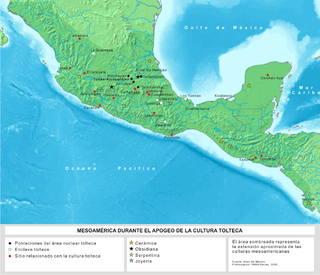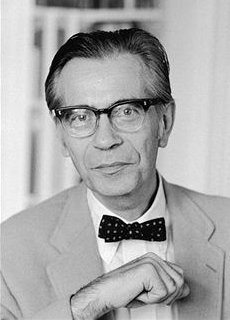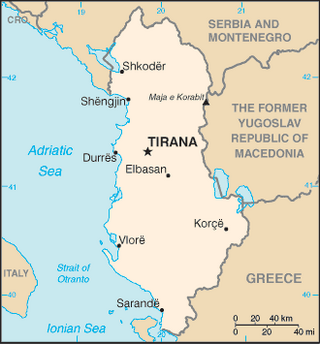Related Research Articles

The Toltec culture was a pre-Columbian Mesoamerican culture that ruled a state centered in Tula, Hidalgo, Mexico, during the Epiclassic and the early Post-Classic period of Mesoamerican chronology, reaching prominence from 950 to 1150 CE. The later Aztec culture considered the Toltec to be their intellectual and cultural predecessors and described Toltec culture emanating from Tōllān as the epitome of civilization. In the Nahuatl language the word Tōltēkatl (singular) or Tōltēkah (plural) came to take on the meaning "artisan". The Aztec oral and pictographic tradition also described the history of the Toltec Empire, giving lists of rulers and their exploits.

Kenzaburō Ōe was a Japanese writer and a major figure in contemporary Japanese literature. His novels, short stories and essays, strongly influenced by French and American literature and literary theory, deal with political, social and philosophical issues, including nuclear weapons, nuclear power, social non-conformism, and existentialism. Ōe was awarded the 1994 Nobel Prize in Literature for creating "an imagined world, where life and myth condense to form a disconcerting picture of the human predicament today".

The 1900 Galveston hurricane, also known as the Great Galveston hurricane and the Galveston Flood, and known regionally as the Great Storm of 1900 or the 1900 Storm, is the deadliest natural disaster in United States history. The strongest storm of the 1900 Atlantic hurricane season, it left between 6,000 and 12,000 fatalities in the United States; the number most cited in official reports is 8,000. Most of these deaths occurred in and near Galveston, Texas, after the storm surge inundated the coastline and the island city with 8 to 12 ft of water. It remains among the deadliest Atlantic hurricanes on record. In addition to the number killed, the storm destroyed about 7,000 buildings of all uses in Galveston, which included 3,636 demolished homes; every dwelling in the city suffered some degree of damage. The hurricane left approximately 10,000 people in the city homeless, out of a total population of fewer than 38,000. The disaster ended the Golden Era of Galveston, as the hurricane alarmed potential investors, who turned to Houston instead. In response to the storm, three engineers designed and oversaw plans to raise the Gulf of Mexico shoreline of Galveston Island by 17 ft (5.2 m) and erect a 10 mi (16 km) seawall.

Richard Hofstadter was an American historian and public intellectual of the mid-20th century. Hofstadter was the DeWitt Clinton Professor of American History at Columbia University. Rejecting his earlier historical materialist approach to history, in the 1950s he came closer to the concept of "consensus history", and was epitomized by some of his admirers as the "iconic historian of postwar liberal consensus." Others see in his work an early critique of the one-dimensional society, as Hofstadter was equally critical of socialist and capitalist models of society, and bemoaned the "consensus" within the society as "bounded by the horizons of property and entrepreneurship", criticizing the "hegemonic liberal capitalist culture running throughout the course of American history".

The Federal Theatre Project was a theatre program established during the Great Depression as part of the New Deal to fund live artistic performances and entertainment programs in the United States. It was one of five Federal Project Number One projects sponsored by the Works Progress Administration, created not as a cultural activity but as a relief measure to employ artists, writers, directors, and theater workers. National director Hallie Flanagan shaped the FTP into a federation of regional theaters that created relevant art, encouraged experimentation in new forms and techniques, and made it possible for millions of Americans to see live theatre for the first time. Although The Federal Theatre project consumed only 0.5% of the allocated budget from the WPA and was widely considered a commercial and critical success, the project became a source of heated political contention. Congress responded to the project's racial integration and accusations of Communist infiltration and cancelled its funding effective June 30, 1939. One month before the project's end, drama critic Brooks Atkinson summarized: "Although the Federal Theatre is far from perfect, it has kept an average of ten thousand people employed on work that has helped to lift the dead weight from the lives of millions of Americans. It has been the best friend the theatre as an institution has ever had in this country."

Redburn: His First Voyage is the fourth book by the American writer Herman Melville, first published in London in 1849. The book is semi-autobiographical and recounts the adventures of a refined youth among coarse and brutal sailors and the seedier areas of Liverpool. Melville wrote Redburn in less than ten weeks. While one scholar describes it as "arguably his funniest work", scholar F. O. Matthiessen calls it "the most moving of its author's books before Moby-Dick".
Postmodern feminism is a mix of post-structuralism, postmodernism, and French feminism. The goal of postmodern feminism is to destabilize the patriarchal norms entrenched in society that have led to gender inequality. Postmodern feminists seek to accomplish this goal through rejecting essentialism, philosophy, and universal truths in favor of embracing the differences that exist amongst women to demonstrate that not all women are the same. These ideologies are rejected by postmodern feminists because they believe if a universal truth is applied to all women of society, it minimizes individual experience, hence they warn women to be aware of ideas displayed as the norm in society since it may stem from masculine notions of how women should be portrayed.

Parable of the Sower is a 1993 speculative fiction novel by American writer Octavia E. Butler. It is set in a post-apocalyptic Earth heavily affected by climate change and social inequality. The novel follows Lauren Olamina, a young woman who can feel the pain of others and becomes displaced from her home. Several characters from various walks of life join her on her journey north and learn of a religion she has discovered and titled Earthseed. The main tenets of Earthseed are that "God is Change" and believers can "shape God" through conscious effort to influence the changes around them. Earthseed also teaches that it is humanity's destiny to inhabit other planets and spread the "seeds" of the Earth.
George Woodman Hilton was a United States historian and economist, who specialized in social history, transportation economics, regulation by commission, the history of economic thought and labor history.

The history of Galveston, Texas, begins with the archaeological record of Native Americans who used the island. The first European settlements on the island were constructed around 1816. The Port of Galveston was established in 1825 by the Congress of Mexico following its successful revolution from Spain. The city served as the main port for the Texas Navy during the Texas Revolution. Galveston was founded in 1836 by Michel Menard, Samuel May Williams, and Thomas F. McKinney, and briefly served as the capital of the Republic of Texas. The Battle of Galveston was fought in Galveston Bay during the American Civil War when Confederate forces under Major General John B. Magruder attacked and expelled occupying Union troops from the city.
Gender essentialism is a theory which attributes distinct, intrinsic qualities to women and men. Based in essentialism, it holds that there are certain universal, innate, biologically based features of gender that are at the root of many of the group differences observed in the behavior of men and women. In Western civilization, it is suggested in writings going back to ancient Greece. With the advent of Christianity, the earlier Greek model was expressed in theological discussions as the doctrine that there are two distinct sexes, male and female, created by God, and that individuals are immutably one or the other. This view remained largely unchanged until the middle of the 19th century. This changed the locus of the origin of the essential differences from religion to biology, in Sandra Bem's words, "from God's grand creation [to] its scientific equivalent: evolution's grand creation," but the belief in an immutable origin had not changed.

The Samuel May Williams House is a former museum in Galveston, Texas. The second-oldest surviving residence in Galveston, it is now on the National Register of Historic Places. It was designated a Recorded Texas Historic Landmark in 1964.
Philip Ainsworth Means was an American anthropologist, historian, and author. He was best known for his study of South America, specifically of the Inca Empire. Means made five extended trips to Peru where he studied the Incas of the Cuzco area and supervised excavations. He was the director of the National Museum of Archeology in Lima, Peru, and was associated with the Smithsonian Institution and the Peabody Museum of Archaeology and Ethnology. Means published many books, including Ancient Civilization of the Andes (1931), which became the standard textbook on Incan history and culture.

This is a list of books in the English language which deal with Albania and its geography, history, inhabitants, culture, biota, etc.
Wendy Ann Ashmore was an American professor of Maya archaeology at the University of California, Riverside. She was involved in excavations in Belize, Guatemala, and Honduras. Her research focused on the implications that spaces, settlement patterns, and gender can have on social organization. She received her B.A. from the University of California, Los Angeles in 1970 and her Ph.D. in 1981 from the University of Pennsylvania. Her dissertation analyzed the results of the site periphery program that took place between 1975 and 1979 at Quirigua, Guatemala. In her dissertation, she discusses the use of random sampling in the Maya region and offers suggestions for how research might be carried out in that region in the future. In the 1980s she taught archaeology at Rutgers University. She left for a position at the University of Pennsylvania. Ashmore died in 2019 at her home in Riverside, California.

Against Sadomasochism: A Radical Feminist Analysis is a 1982 radical feminist anthology edited by Robin Ruth Linden, Darlene R. Pagano, Diana E. H. Russell, and Susan Leigh Star. The authors critique sadomasochism and BDSM, with most identifying sadomasochism as rooted in "patriarchal sexual ideology".
Susan Kathleen Cahn is a historian known for her work on women's studies and LGBTQ topics. She is a professor at the University of Buffalo.
Tejano South Texas: A Mexican American Cultural Province is a 2002 non-fiction book by Daniel D. Arreola, published by the University of Texas Press. It discusses the South Texas region and Mexican American culture within the region.
The Inland Whale is a 1959 book by Theodora Kroeber. It is a retelling of nine pieces of Indigenous American folklore, along with authorial commentary. Kroeber's prose received praise, though a reviewer noted that she had taken some liberties with the narratives. The book was described as a work of comparative literature, that sought to demonstrate the literary merit of indigenous oral traditions.
The Jew in American Cinema is a 1984 non-fiction book by Patricia Erens, published by Indiana University Press.
References
- Bixel, Patricia B. (August 2005). "Mythic Galveston: Reinventing America's Third Coast". Journal of Southern History . 71 (2): 718+. doi:10.2307/27648871. JSTOR 27648871 . Retrieved 2022-09-03– via Gale Academic OneFile.
- Butler, Patrick H. III (2003). "Mythic Galveston: Reinventing America's Third Coast Susan Wiley Hardwick". The Public Historian . 25 (4): 135–136. doi:10.2307/3379282. JSTOR 3379282.
- Hugill, Peter J. (2004). "Mythic Galveston: Reinventing America's Third Coast". Professional Geographer . 56 (1): 148–149. doi:10.1111/j.0033-0124.2004.05601020_5.x.
- Maroney, James C. (2004-06-01). "Mythic Galveston: Reinventing America's Third Coast. By Susan Wiley Hardwick. (Baltimore: Johns Hopkins University Press, 2002. xiv, 175 pp. $42.95, ISBN 0-8018-6887-4.)". Journal of American History . 91 (1): 274–275. doi:10.2307/3659704. JSTOR 3659704.